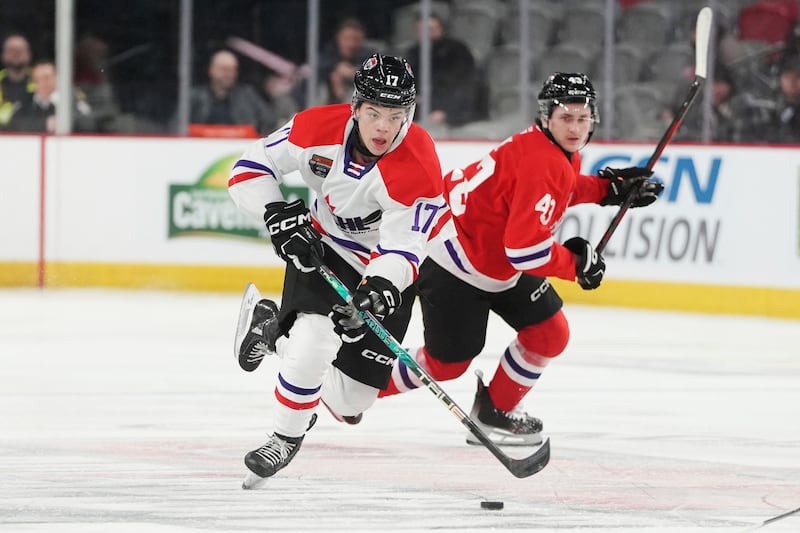When Tij Iginla, the first player ever drafted by the Utah Mammoth franchise, underwent double hip surgery at age 18, the instant reaction from the hockey world was one of concern — hip surgery is for the elderly, everyone thought.
But in Iginla’s case, it’s not necessarily as big a deal as one might think.
Arthroscopic hip surgery, which is what Iginla underwent, is commonly used to treat femoroacetabular impingement (FAI for short). It removes bone abnormality on the femur or hip socket, which can rub in an uncomfortable way and eventually lead to arthritis.
It’s especially common in young athletes, as excessive movement can aggravate various components of the joint.
FAI is most commonly genetic and present from birth, according to the Mayo Clinic. Iginla’s father, Hockey Hall of Famer Jarome Iginla, had hip resurfacing surgery — a much more invasive procedure — at the end of his career, which can be needed if FAI goes untreated.
“Overuse was the main reason I needed it,” Iginla told RocketFan.ca. “Skating can put more strain on the hips compared to other sports, so over time, it wears down the joint.”
Tij Iginla’s hip surgeries
In a standard arthroscopic hip surgery for FAI treatment, the surgeon makes several incisions less than an inch in length and uses a camera to manipulate tools that shave down the problematic part of the bone. In some cases, they will also repair a torn labrum.
It’s roughly a two-hour procedure and is less invasive than many other forms of surgery.
It requires several months of rehabilitation and rest, limiting Iginla’s playing time to just 21 WHL games to start the season. He’s still not quite cleared for contact, but he says he should be good to go around late July.
“Obviously it wasn’t what I would have probably expected, at 18 years old getting double hip surgery, but I think a lot of good will come from it,” Iginla said in an interview ahead of Mammoth development camp on June 29.
He had his right hip done first, followed by his left one six and a half weeks later. Doing it that way allowed him the mobility of crutches, rather than needing a wheelchair. Although he couldn’t do the type of training that he’s used to, he did find ways to get better at hockey as he recovered — including the use of virtual reality.
He also mentioned the mental side of the game as a focal point.
“I think there’s a certain aspect of resilience that you have to have, going through that,” he said. “Keeping a good head space and finding ways to keep getting better. For someone like me, that’s what keeps me sane going through something like that, knowing that I’m not just sitting on the couch getting worse.”
He also spent time watching Utah’s games, as well as those of his younger brother, Joe, who plays for the Edmonton Oil Kings, and his older sister, Jade, who plays for Brown University.
Could Tij Iginla’s hip problems end his career?
The Mayo Clinic estimates that between 85% and 95% of athletes recover fully after having arthroscopic hip surgery to treat FAI. By all accounts, Iginla is expected to be among the majority.
FAI is not altogether uncommon in hockey. Many players have had it treated through surgery, including:
- Ian Cole (2019)
- Jakob Silfverberg (2021)
- Tyler Seguin (2024)
- Brad Marchand (2022)
- Jamie Benn (2015)
While there’s no comprehensive list, every player listed above fully recovered after having arthroscopic surgery. But there’s at least one who didn’t.
At age 19, John Klingberg had the surgery in both hips. It didn’t solve the problem, so at age 21, he had it again. It still didn’t fix the issue, leading him to develop arthritis and forcing him to play through pain his entire career.
At age 31, he had hip resurfacing surgery, which he says has cleared all the pain.
Klingberg has still managed to have an above-average career, but the question looms large as to how much more success he would have had with healthy hips.
How good will Tij Iginla be?
The last name on the back of Iginla’s jersey comes with high expectations — and he could very well meet them. He’s the highest-drafted member of his family thus far, though precisely 1,300 NHL points separate his father from him.
He models his game after Colorado Avalanche superstar Nathan MacKinnon.
“He’s so powerful, great skater, such a great offensive mind, very well-rounded, great shooter, kind of a dual threat,” he said.
Of course, Iginla is on a short list of people who have hosted MacKinnon for Thanksgiving dinner, which happened during his father’s time with the Avalanche.
Iginla’s most dangerous tool is his shot, which can be lumped in with that of Auston Matthews and Connor Bedard, among others, as one of the best in the world. General manager Bill Armstrong famously told him on his draft day that Utah needs him to be a 50-goal scorer — and with his shot, it’s certainly possible.
Last season was his most productive in the WHL in terms of points per game (1.5). He had five points in his final contest, a 9-1 Kelowna Rockets win over the Regina Pats.
Losing more than half a season to injury could prove to be a speed bump in his development, though the extra year of physical and mental maturity could outweigh any disadvantage he may have had.
“He’s a really talented player,” said Lee Stempniak, director of player development for the Mammoth. “He can shoot the puck. Great offensive brain. To me, he looks like he hasn’t missed a step.”
The Rockets’ season kicks off with a bout against the Spokane Chiefs on Sept. 19. Fans can catch WHL games for free on Victory+.


